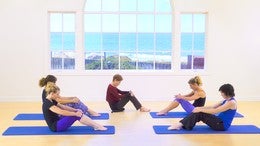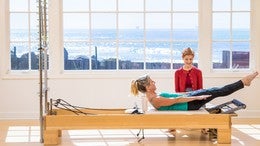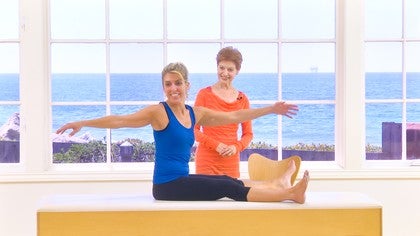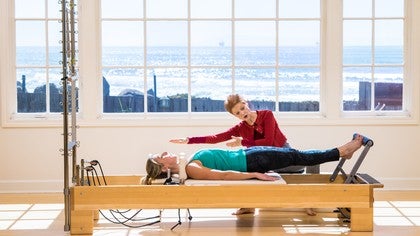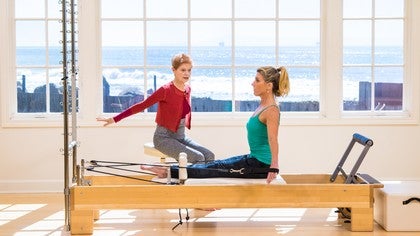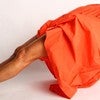Description
In addition to the foam pieces that Judith adds for the shoulders, she also uses a Medium Seat Wedge under the pelvis.
About This Video
Transcript
Read Full Transcript
Okay. We're onto another application of Aston Kinetics for the reformer. This one is the footwork and Kristy, I'm going to have you do it again pretty much the way you often do it. This particular version. Yeah. While she's doing this, you said, okay, that you just keep going while she's doing this. What I'd like you to feel, Christie and the rest of you to look for. How far does the movement travel through her body?
You've seen most of it going into her legs. You see quite a bit of hyperextension at the knee. I don't see much movement going past her hip joint actually. Okay. Um, one of my interests is that every movement we do will have some ratio of that same movement goes through the entire body. It may not be the same amplitude in force, but it does demonstrate that it is translating through the body.
So let me just talk about that for a moment, Kristen. So here, this is Mr bones and I'm going to hold him by his head. Um, when the body plays with these two forces that we have here on this planet, gravity pushing us down and ground reaction pushing us off the earth toward the stars. When a body is better aligned, both of those directions of gravity on the down and GRF on the up will translate through the entire body, okay? In this case, when her legs are that far in front of her pelvis and alignment to her head, when she pushes, that force goes mainly into the back. So that translation of force doesn't go through the trunk, the neck and the head, okay, let me demonstrate that for you on my own body,
If you're looking on this wall right here behind me, you'll see it go through when I bring my feet out to the degree that she is, and I'll just lean on this wall for right.
Keep going right there. Now go ahead. Beautiful. Come on back and feel the push off your feet. Go through your body and a little bit through to your head. See if you can imagine. Now, one of the reasons it can't go through your head pause is that the angle is flexing your neck and head, putting the head on the front part of the neck. So if you'll drop that two flat.
So now she's in, when she extends, you'll see she's in a nice diagonal all the way from a little higher here, little less high all the way to her head. So Nancy, if you can feel the movement go all the way through your body, you can definitely, she said very nice. Now when we have this push off, this ground reaction, there is always the opportunity for a moment of suspension at the top. It's like being in an elevator. Okay? And you start to get to the top. There's that moment where you feel suspended before you kind of land. Yeah. Yeah. So that comes from the force pulling us up to the whatever floor.
This is the force. It's translate. See if you can imagine that it goes out your head. And that determines when you bend your knees to come back rather than some rhythm. You're doing it by how you feel, the translation of the forces going through your body. You're still getting the excellence of this beautiful exercise. You're just letting your whole body be involved.
Very nice. Can you feel the difference? Okay. And then once you think for a little bit, then you can stop the thinking and feel. And when you're ready. I have one more little idea. Okay. When you have a body that has one leg longer than the other and that person jumps in the air, which leg is going to hit first? Generally the longer leg? Yes.
So it goes right, but a lot of times people are so used to doing things bilaterally symmetrical that they create additional compression in the leg and extra extension and strip length, toning in forced length in the shorter leg. Trying to pretend it's longer. Okay, so I suggest people play with what I call this asymmetrical push off. Push off. So it's one foot in the other foot. It's almost imperceptible to the eye. You'll feel which one it feels better to do.
Okay. And now go ahead and let that go through and see if you can feel the asymmetry. Maybe go through your whole body. Boom, boom, boom, boom, boom, boom, boom. It's almost like a feathering, we call it,
I'm going to take this out. Please contrast the way you did it the first time. Head up and just identify some of the differences for yourself. And I suggest you do the same. Bizarre.
You tell me. Well, for one I'm, I'm all of a sudden having to rethink about the needs a lot more cause I can feel it, the energy drop there. I'm not really sure how it gets passed there, but then I feel it again dropping here. Um, I'm aware of the firmness of my sacrum, so I guess those pressure. Yeah, I can feel that a lot and
And so it's this idea of just wavering in between and when this wavering happens through the body, it just engages more of the body, whether it's for toning, whether it's for loosening, whether it's for stretching. One of the things I'd like Christie to feel is a, just putting a little piece of foam right here above the shoulders so that it's not a solid firm end range for her shoulder that she pushes against, but that she has some give in there. You could use a towel on this piece of foam on this. Go ahead and, and just see if you can feel what that suggestion makes
But if you have just a little bit of cushion, it's amazing. How, Huh? Energetic block. Okay. The suggestion is it stops there. Yeah. Okay.
Mindful Movement: Applying Aston Kinetics
Comments
.http://www.pilatescente rofaustin.com/videos.html
Thanks E.A.!
where do i purchase the pads you used on the shoulder rest and which pad from your site did you use with kristi on the reformer?
thanks!
You need to be a subscriber to post a comment.
Please Log In or Create an Account to start your free trial.
